+ Open data
Open data
- Basic information
Basic information
| Entry | Database: PDB / ID: 7xex | ||||||
|---|---|---|---|---|---|---|---|
| Title | Crystal strucutre of apoCasDinG | ||||||
 Components Components | CasDinG | ||||||
 Keywords Keywords | STRUCTURAL PROTEIN / Nuclease | ||||||
| Biological species |  | ||||||
| Method |  X-RAY DIFFRACTION / X-RAY DIFFRACTION /  SYNCHROTRON / SYNCHROTRON /  MOLECULAR REPLACEMENT / Resolution: 3 Å MOLECULAR REPLACEMENT / Resolution: 3 Å | ||||||
 Authors Authors | Zhang, J.T. / Cui, N. / Liu, Y.R. / Huang, H.D. / Jia, N. | ||||||
| Funding support | 1items
| ||||||
 Citation Citation |  Journal: Mol Cell / Year: 2023 Journal: Mol Cell / Year: 2023Title: Type IV-A CRISPR-Csf complex: Assembly, dsDNA targeting, and CasDinG recruitment. Authors: Ning Cui / Jun-Tao Zhang / Yongrui Liu / Yanhong Liu / Xiao-Yu Liu / Chongyuan Wang / Hongda Huang / Ning Jia /  Abstract: Type IV CRISPR-Cas systems, which are primarily found on plasmids and exhibit a strong plasmid-targeting preference, are the only one of the six known CRISPR-Cas types for which the mechanistic ...Type IV CRISPR-Cas systems, which are primarily found on plasmids and exhibit a strong plasmid-targeting preference, are the only one of the six known CRISPR-Cas types for which the mechanistic details of their function remain unknown. Here, we provide high-resolution functional snapshots of type IV-A Csf complexes before and after target dsDNA binding, either in the absence or presence of CasDinG, revealing the mechanisms underlying Csf complex assembly, "DWN" PAM-dependent dsDNA targeting, R-loop formation, and CasDinG recruitment. Furthermore, we establish that CasDinG, a signature DinG family helicase, harbors ssDNA-stimulated ATPase activity and ATP-dependent 5'-3' DNA helicase activity. In addition, we show that CasDinG unwinds the non-target strand (NTS) and target strand (TS) of target dsDNA from the Csf complex. These molecular details advance our mechanistic understanding of type IV-A CRISPR-Csf function and should enable Csf complexes to be harnessed as genome-engineering tools for biotechnological applications. | ||||||
| History |
|
- Structure visualization
Structure visualization
| Structure viewer | Molecule:  Molmil Molmil Jmol/JSmol Jmol/JSmol |
|---|
- Downloads & links
Downloads & links
- Download
Download
| PDBx/mmCIF format |  7xex.cif.gz 7xex.cif.gz | 670.7 KB | Display |  PDBx/mmCIF format PDBx/mmCIF format |
|---|---|---|---|---|
| PDB format |  pdb7xex.ent.gz pdb7xex.ent.gz | 562.2 KB | Display |  PDB format PDB format |
| PDBx/mmJSON format |  7xex.json.gz 7xex.json.gz | Tree view |  PDBx/mmJSON format PDBx/mmJSON format | |
| Others |  Other downloads Other downloads |
-Validation report
| Summary document |  7xex_validation.pdf.gz 7xex_validation.pdf.gz | 450.4 KB | Display |  wwPDB validaton report wwPDB validaton report |
|---|---|---|---|---|
| Full document |  7xex_full_validation.pdf.gz 7xex_full_validation.pdf.gz | 471.4 KB | Display | |
| Data in XML |  7xex_validation.xml.gz 7xex_validation.xml.gz | 59.1 KB | Display | |
| Data in CIF |  7xex_validation.cif.gz 7xex_validation.cif.gz | 79.8 KB | Display | |
| Arichive directory |  https://data.pdbj.org/pub/pdb/validation_reports/xe/7xex https://data.pdbj.org/pub/pdb/validation_reports/xe/7xex ftp://data.pdbj.org/pub/pdb/validation_reports/xe/7xex ftp://data.pdbj.org/pub/pdb/validation_reports/xe/7xex | HTTPS FTP |
-Related structure data
| Related structure data |  7xf0C 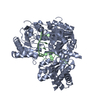 7xf1C  7xfzC 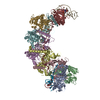 7xg0C 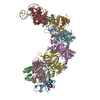 7xg2C 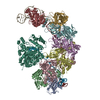 7xg3C 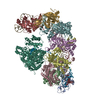 7xg4C 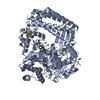 6fwrS S: Starting model for refinement C: citing same article ( |
|---|
- Links
Links
- Assembly
Assembly
| Deposited unit | 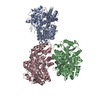
| ||||||||
|---|---|---|---|---|---|---|---|---|---|
| 1 | 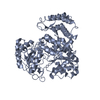
| ||||||||
| 2 | 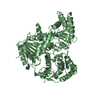
| ||||||||
| 3 | 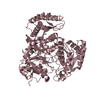
| ||||||||
| Unit cell |
|
- Components
Components
| #1: Protein | Mass: 67939.883 Da / Num. of mol.: 3 Source method: isolated from a genetically manipulated source Details: Sequence based on database WP_088922490.1 / Source: (gene. exp.)   |
|---|
-Experimental details
-Experiment
| Experiment | Method:  X-RAY DIFFRACTION / Number of used crystals: 1 X-RAY DIFFRACTION / Number of used crystals: 1 |
|---|
- Sample preparation
Sample preparation
| Crystal | Density Matthews: 2.8 Å3/Da / Density % sol: 56.03 % |
|---|---|
| Crystal grow | Temperature: 289.15 K / Method: vapor diffusion, hanging drop / Details: 8% PEG 6000, 0.1M HEPES 7.4 |
-Data collection
| Diffraction | Mean temperature: 100 K / Serial crystal experiment: N |
|---|---|
| Diffraction source | Source:  SYNCHROTRON / Site: SYNCHROTRON / Site:  SSRF SSRF  / Beamline: BL18U1 / Wavelength: 0.97915 Å / Beamline: BL18U1 / Wavelength: 0.97915 Å |
| Detector | Type: DECTRIS PILATUS3 S 6M / Detector: PIXEL / Date: Jul 19, 2021 |
| Radiation | Protocol: SINGLE WAVELENGTH / Monochromatic (M) / Laue (L): M / Scattering type: x-ray |
| Radiation wavelength | Wavelength: 0.97915 Å / Relative weight: 1 |
| Reflection | Resolution: 3→40 Å / Num. obs: 44576 / % possible obs: 98.1 % / Redundancy: 6.7 % / Biso Wilson estimate: 54.72 Å2 / CC1/2: 0.845 / Net I/σ(I): 12 |
| Reflection shell | Resolution: 3→3.11 Å / Num. unique obs: 4125 / CC1/2: 0.845 |
- Processing
Processing
| Software |
| ||||||||||||||||||||||||||||||||||||||||||||||||||||||||||||||||||||||||||||||||||||||||||||||||||||
|---|---|---|---|---|---|---|---|---|---|---|---|---|---|---|---|---|---|---|---|---|---|---|---|---|---|---|---|---|---|---|---|---|---|---|---|---|---|---|---|---|---|---|---|---|---|---|---|---|---|---|---|---|---|---|---|---|---|---|---|---|---|---|---|---|---|---|---|---|---|---|---|---|---|---|---|---|---|---|---|---|---|---|---|---|---|---|---|---|---|---|---|---|---|---|---|---|---|---|---|---|---|
| Refinement | Method to determine structure:  MOLECULAR REPLACEMENT MOLECULAR REPLACEMENTStarting model: 6FWR Resolution: 3→38.37 Å / SU ML: 0.37 / Cross valid method: THROUGHOUT / σ(F): 1.36 / Phase error: 28.09 / Stereochemistry target values: ML
| ||||||||||||||||||||||||||||||||||||||||||||||||||||||||||||||||||||||||||||||||||||||||||||||||||||
| Solvent computation | Shrinkage radii: 0.9 Å / VDW probe radii: 1.11 Å / Solvent model: FLAT BULK SOLVENT MODEL | ||||||||||||||||||||||||||||||||||||||||||||||||||||||||||||||||||||||||||||||||||||||||||||||||||||
| Displacement parameters | Biso max: 135.13 Å2 / Biso mean: 53.8184 Å2 / Biso min: 10.75 Å2 | ||||||||||||||||||||||||||||||||||||||||||||||||||||||||||||||||||||||||||||||||||||||||||||||||||||
| Refinement step | Cycle: final / Resolution: 3→38.37 Å
| ||||||||||||||||||||||||||||||||||||||||||||||||||||||||||||||||||||||||||||||||||||||||||||||||||||
| LS refinement shell | Refine-ID: X-RAY DIFFRACTION / Rfactor Rfree error: 0 / Total num. of bins used: 13
| ||||||||||||||||||||||||||||||||||||||||||||||||||||||||||||||||||||||||||||||||||||||||||||||||||||
| Refinement TLS params. | Method: refined / Refine-ID: X-RAY DIFFRACTION
| ||||||||||||||||||||||||||||||||||||||||||||||||||||||||||||||||||||||||||||||||||||||||||||||||||||
| Refinement TLS group |
|
 Movie
Movie Controller
Controller








 PDBj
PDBj